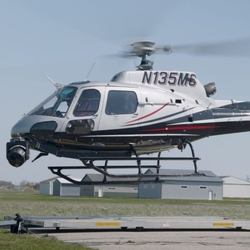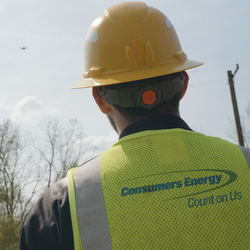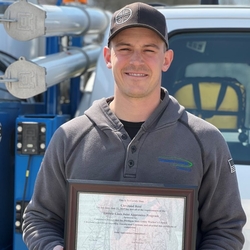Serving Customers by Air, Land and Water
 These scenarios all add up to some of the unique ways our dedicated crews, and those behind-the-scenes, go the extra mile for our nearly 2 million electric customers by air, land and water.
These scenarios all add up to some of the unique ways our dedicated crews, and those behind-the-scenes, go the extra mile for our nearly 2 million electric customers by air, land and water.
Aided by these tools and other advanced technology we are committed to keeping our customers’ power on. And as Mother Nature continues to become more unpredictable with violent storms pummeling Michigan’s grid, these tools are vital in helping us restore power in a timely manner while also making our grid stronger.
It's all part of the course we are charting through our Reliability Roadmap: our long-term goal to make sure no single outage affects more than 100,000 customers and all power outages are restored within 24 hours.
Birds Eye View
Tommy Webb and the helicopter crew are one of the teams assisting from a bird’s eye view. They use data obtained from inspecting power lines and other infrastructure to help in our expansive reliability efforts.
“We know the importance of working together to make sure our grid is as strong as possible,” said Webb, Senior Engineer Tech Analyst and helicopter crew member.
The crew uses a camera with thermal and ultraviolet sensors to inspect high voltage distribution lines.
The crew also helps identify areas where tree trimming might be necessary due to fallen trees and broken limbs. Trees continue to be a leading cause of outages which is why we are investing more than $500 million over the next five years to keep overhead lines clear.
“We all have a role in shaping our reliability future,” Webb said. “Our role, at times, just happens to take place a few hundred feet in the air.”
Drones at Your Service
Drones are also part of our aerial fleet helping us inspect our electric lines around the state.
Ben Strandskov leads our drone program. Strandskov and 30 other licensed drone operators use specialized drones to take videos and photos of our power lines to determine if there are any downed wires or damage to poles including cross arms, insulators and cutout switches.
This is especially valuable following a storm.
“We are able to safely identify top priority issues in minutes, where in the past it might have taken hours,” Strandskov said. “That allows crews to focus on fixing any issues identified with our electric lines. We work in tandem with our helicopter crew to get to tough places crews aren’t able to. That includes about 400 miles of lines they can’t get to easily for reasons including thick brush and helicopters not being allowed in the area.”
Exploring Ways to Improve Reliability Efforts
 Most of our work continues to be above ground, but we are exploring ways to improve our reliability by burying our electric lines.
Most of our work continues to be above ground, but we are exploring ways to improve our reliability by burying our electric lines.
Currently, about 15% of our electric lines are underground and many of these locations are in subdivisions and areas with high population density.
Kail Robinson, who works with underground voltage, is looking forward to being part of this important chapter in the company’s history.
“It’s an exciting time to be an underground lineworker,” he said. “We really work well together as a team, and it has been great to work with different work groups like dispatch, overhead line crews and the meter shop.
In addition to using currently available tools, we won’t stop implementing new technology to protect the grid.
Our crews are proactively installing new devices, such as Automatic Transfer Reclosers (ATRs).
When outages occur, ATRs deenergize impacted electric lines and transfer power automatically, reducing outages and their impacts to customers.
While technological advances in our industry continue at a rapid rate, overhead linework will still be at the forefront of our reliability future. We are replacing older poles with stronger ones that have fiberglass cross arms that will be able to stand up to whatever Mother Nature throws at us.
Cleveland Reid, a lineworker, said he looks forward to working with all the teams tasked with improving customers’ reliability.
“Consumers Energy sets a high standard for providing safe, reliable service for every single one of our customers,” said Reid. “And that can be felt in the field and it’s something we take seriously every day we interact with customers. We will continue to provide them with the service they expect, and they deserve from us.”
Splish Splash
 Aquatic vehicles make it possible for crews to serve hard-to-reach areas where it is virtually impossible for bucket trucks and other equipment to access.
Aquatic vehicles make it possible for crews to serve hard-to-reach areas where it is virtually impossible for bucket trucks and other equipment to access.
Jerry Gates, a lineworker who is one of the drivers of the machine, said it is used in special situations.
“If a pole is in the water and needs to be replaced because it’s broken or aging – this is what we use,” said Gates, pointing to the 6,000-pound machine that looks straight out of the military.
A recent water venture called for an inspection of a pole and its cross arm and transformer. Since conditions make the use of a bucket truck impossible, a member of the crew must scale the pole to make sure everything is functioning properly.
An onlooker who stays at a nearby campsite, Art Heudecker, watched the crew from his golf cart in marvel.
“It’s great to see these crews at work, no matter if it’s in the water, in the air or on the ground,” he said. “Whenever and wherever they are out, it gives us all peace of mind that Consumers Energy is hard at work providing us reliable service.”